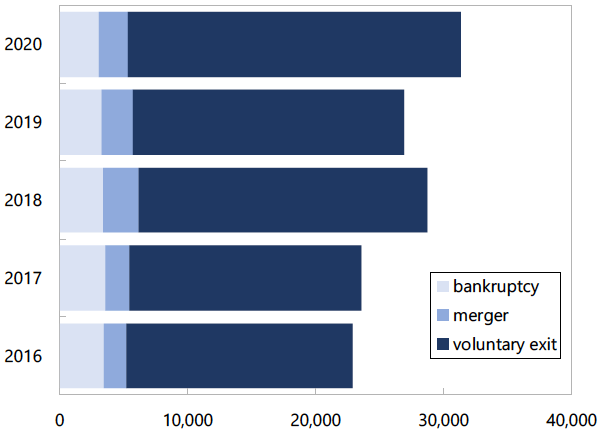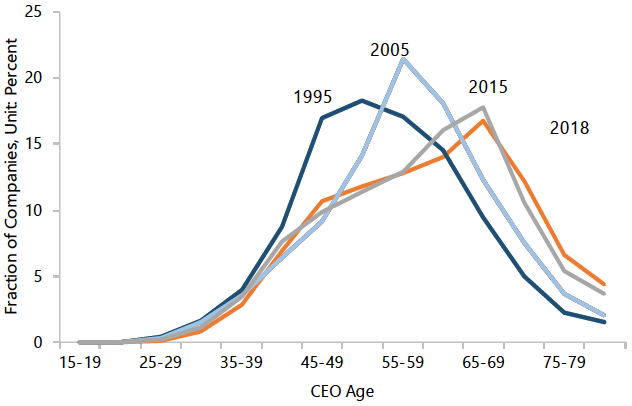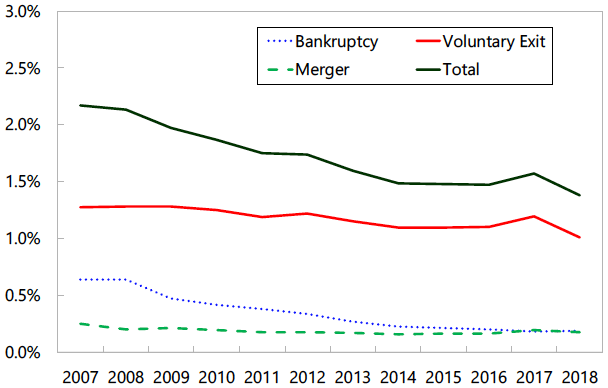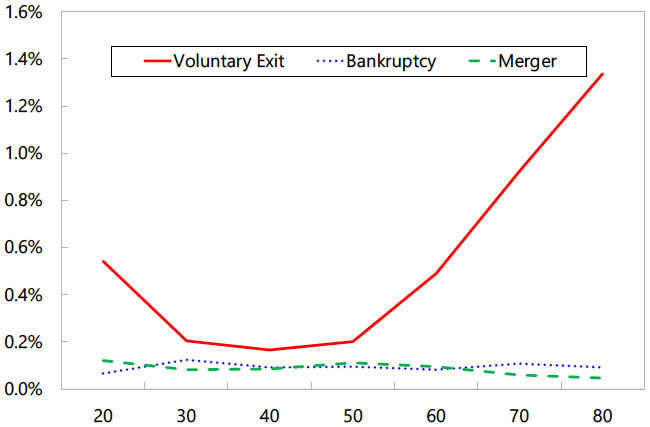The COVID-19 shock has posed a significant threat to business survival of Japanese firms, especially small and medium-sized enterprises (SMEs) that are dominantly present in those sectors that are most vulnerable to reduced mobility due to containment measures. Using a unique firm-level data with information on firm exits of Japanese firms, we find that total number of firm exits from January to May this year rose by 16 percent relative to last year, driven by voluntary exits rather than bankruptcies. This suggests that at least in the initial phase of the pandemic, pre-existing structural issues of Japanese SMEs regarding the difficulties of business continuation—involving aging business owners without business successors exacerbated by the COVID-19 shock—triggered elderly business owners to quit their businesses, even, in some cases, exiting firms that were solvent.
1. Introduction
The COVID-19 shock has posed a significant threat to business survival across the globe. Lockdowns and other containment measures have led to a disrupted supply and collapse in demand as consumers were either forced to exercise or voluntarily exercised social distancing. Despite an unprecedented degree of policy support to prevent bankruptcies and job losses, firms continue to face severe liquidity constraints due to collapsed revenues and cashflow pressures.
Japanese firms have also been severely affected by the COVID-19 shock, despite aggressive fiscal and monetary support by policymakers to ensure the survival of firms and protect employment. The situation is particularly dire for small and medium-sized enterprises (SMEs, hereafter), which account for nearly 70 percent of total employment in Japan, which are highly concentrated in sectors that involve high degree of human contact such as retail, tourism and accommodation sectors and are therefore most vulnerable to reduced mobility (Miyakawa, 2020).
In this column, we document how the COVID-19 crisis has affected firm exit so far in Japan. To address this issue, we use of a unique monthly firm-level dataset with detailed information on the type of firm exits up to May 2020, allowing us to evaluate the impact of the COVID-19 shock on firm exits during the initial stage of the crisis.
We find that total number of firm exits increased during the pandemic. The cumulative number of firm exits during the pandemic (defined as the total number of firm exits from January to May 2020) rose by 16 percent relative to the same period last year. The increase in the number of firm exits is driven by a sharp increase in voluntary exits. On the other hand, there is no sign of an increase in bankruptcies thus far in 2020, as the number of firm exits due to bankruptcy declined relative to the same period last year. This highlights that in the initial phase of the pandemic, the COVID-19 shock worked as an accelerator to the pre-existing trend where aging business owners, who cannot find business successors, decide to exit voluntarily even in cases where businesses may be solvent.
2. Exit Pattern before and after COVID-19
We use monthly firm-level data from the Tokyo Shoko Research (TSR) containing information on firm sales, characteristics of the CEO, including the age of CEOs, and the type of firm exits if the firm exited during the sample period. Firm exits are categorized into three groups: bankruptcy, merger and voluntary exits (dissolution of companies and business closures). This data covers up to end of-May 2020.
We find that 31,335 Japanese firms exited between January and May of this year. This is about 16 percent higher than the total number of firm exits during the same period in 2019 (26,900 firm exits). This large increase in the total number of firm exits was driven by voluntary exits, which rose by 23 percent annually from 21,173 firms in 2019 to 26,013 firms in 2020. So far, the total number of firm exits due to bankruptcies in 2020 declined by 8 percent annually from 3,304 firms last year from January to May to 3,038 firms during the same period this year (Figure 1). By sector, voluntary exits occurred mostly in the non-manufacturing sector, including construction, retail and other services sectors.

As we will document in the next section, many Japanese firms exited their sector or industry voluntarily, even before the COVID-19 crisis, and the exit ratio of voluntary exits has been larger than exits due to bankruptcy and merger (Hong et al. 2020). The pattern of firm exits that we observe during the COVID-19 crisis is an acceleration of this pre-existing trend in firm exits. The COVID-19 shock worked as a trigger for aging business owners without business successors to quit their businesses, who may have already begun to think about closing their business in the coming years. It is possible that not only financially vulnerable firms, but healthy and solvent firms, might have closed during this period given the bleak economic outlook and difficulties in finding suitable business successors. At least for these firms, the pre-COVID-19 government support such as helping to improve matching between firms and potential successors, may not have helped change their minds in seeking to close their businesses.
One caveat to this finding is that it may be too early to get a full understanding of firm exits by bankruptcies just by looking at the current low rate of bankruptcies. Bankruptcies follow court procedures, which, as in other countries, may have been disrupted due to the state of emergency. A delay in processing court procedures could also be due to an unusually large number of bankruptcy filings, generating a long queue of pending filings. On the other hand, government support for SMEs are likely to have prevented firms from exiting, who might otherwise have been insolvent following the COVID-19 shock. On balance, it will take time to obtain a full grasp of the impact of the COVID-19 shock on firm bankruptcies.
What our finding so far shows clearly, however, is that voluntary exits have been the major form of firm exits during the initial phase of the COVID-19 crisis in Japan, and generous government measures are not likely to have helped avert such trend.
3. Why do Japanese Firms Exit Voluntarily?
In recent years, Japanese firm exit patterns have been influenced by its poor demographics and preponderance of aging business owners. Over the years, the distribution of CEO ages of Japanese SMEs has been shifting to the right, implying that the average age of CEOs has increased (Figure 2).
In 1995, the median age group for business owners was between 50 to 54 years old. In 2018, between 60 to 64 years age group has become the median age group of business owners. Now, more than a third of business owners in Japan are at least 65 years old, and this share has nearly doubled from 18 percent in 1995 in the span of twenty years. And this trend is likely to continue due to Japan’s rapidly aging population. On the other hand, according to a survey by the Small and Medium Enterprises Agency (hereafter, SMEA), nearly half of business owners have not decided on a successor (SMEA, 2018). In addition, for SMEs, “cannot secure successor” is one of the key reasons why business owners are considering voluntary business closures (SMEA 2017).

In fact, demographic factors have been the main driver of firm exit in Japan in recent years, as the firms exited predominantly through voluntary exits. For instance, in 2018, out of total exit rate of 1.3 percent, voluntary exit rates registered 1.0 percent (Figure 3). On the other hand, bankruptcy rates have been declining in recent years as the overall health of Japanese SMEs was improving and zombie firm ratios decreasing, amid better macroeconomic conditions and lax financial conditions. Exits due to merger remain a rare form of exit for Japanese companies.

The correlation between the age of business owners and voluntary exits is clear – that is, voluntary exits increase with CEO age (Figure 4). On the other hand, the correlation between CEO age and firm exit rates is non-existent for other types of firm exits (including bankruptcies and merger) (see Hong et al. 2020). This finding confirms that the issue of business succession is a significant bottleneck for business continuation in Japan for aging CEOs.

4. Policy Implications
During the initial phase of the COVID-19 shock, the increase in the total number of firm exits has been driven by the increase in voluntary firm exits, while the total number of bankruptcies and mergers has declined compared to the previous year. Voluntary exits happened mostly for the SMEs headed by older-age CEOs, who did not secure a business successor. An unintended consequence of voluntary firm exits, especially when the firm is profitable, is long-term losses to employment, investment and productivity. In this regard, as the state of the economy transits from the initial phase of acute shocks to a recovery phase, policy support should factor in the viability and solvency of firms. Unwilling exits of solvent firms should be prevented, as chronic support to insolvent firms could lead to a return of zombie firms and increased moral hazard. In addition, policy initiatives to help prevent voluntary exits of solvent firms should continue. Policies to support business succession—including raising awareness of the importance of this issue, incentivizing non-family succession, and helping to improve matching between firms and potential successors—should continue even during these difficult economic times.
Authors' note: the views expressed in the colun are those of the author and should not be attributed to the IMF, its Executive Board, or its management.



